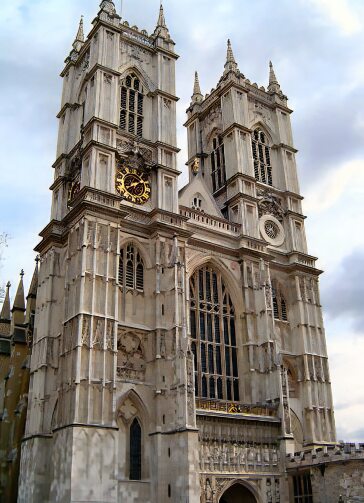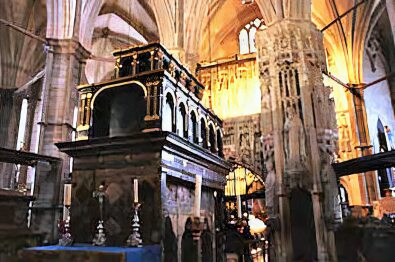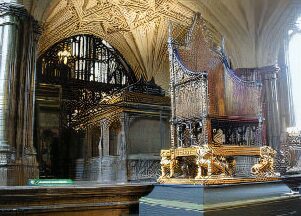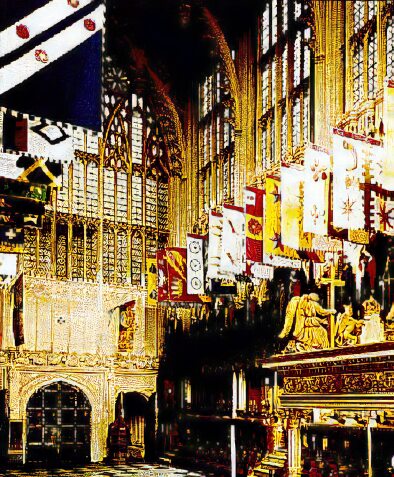One of England's finest Gothic buildings and the country's national shrine, Westminster Abbey was founded by the Saxon king, Edward the Confessor (1042-65) and consecrated on 28th December, 1065, a few days before his death. Known as the Abbey of St. Peter on Thorney Island, named due to the brambles that then covered the area, it was built on the misty low lying marshes which then edged the River Thames. Several churches, dedicated to St. Peter had previously occupied the spot. Tradition states that a shrine was first established at the site in in 616 following reports from a fisherman on the Thames, who claimed to have seen a vision of Saint Peter. The pious King Edward was buried at the newly completed abbey and his posthumous reputation came to be revered.
Edward's succesor, the Saxon King Harold II became the first King of England to be crowned at the abbey in January, 1066. Following his victory over the Harold at the Battle of Hastings in 1066, the NormanWilliam the Conqueror was also crowned at the abbey on Christmas Day, 1066. Every subsequent English monarch, with the exception of Edward V, Edward VIII and Lady Jane Grey have since been crowned there.
The Plantagenet King Henry III (1216-72) revered and venerated St. Edward the Confessor, who had been canonised in 1161, even having a mural painted of him in his bedchamber. He possessed a mania for building and his life's work was the rebuilding of the abbey in the Anglo-French Gothic style. The three master masons supervising the work were Henry of Reyns, John of Gloucester and Robert of Beverley. Building work continued after the death of Henry III, being finally completed by the architect Henry Yevele in the reign of Richard II.
Westminster Abbey, the West Front

The magnificent shrine of St. Edward the Confessor at the heart of the abbey, was constructed by Henry III in 1241. The Confessor's body was carried in stately procession to its new resting place by Henry III himself, along with his younger brother, Richard, Earl of Cornwall. The chest which housed the relics of the saint was composed of precious metal, with a gabled roof. The shrine was to become a popular place of pilgrimage throughout the Middle Ages. Subsequent monarchs made costly offerings at the shrine. Edward I donated the crown of the Welsh prince, Llywelyn along with the rich spoils of his Scottish wars. Richard II made a gift of a silver table enamelled with impressions of the Confessor and the pilgrim. The ionoclasm of the Reformation saw the shrine stripped of its costly offerings by Henry VIII and the Confessor's body was reinterred beneath the stone base. The shrine was later restored by Henry's devout Catholic daughter, Mary I. The abbey was eventually commissioned as a "Royal Peculiar" by Queen Elizabeth I.
The shrine of St. Edward the Confessor

Henry III was buried in the Confessor's Chapel at the abbey in 1272, a magnificent bronze effigy of the king, by William Torel, adorns his tomb, previously his predecessors had been buried at the Abbey of Fontevrault in the Plantagenet lands in France but Westminster Abbey was later to become the mausoleum of English Kings. Henry's son Edward I and daughter-in-law, Eleanor of Castille, lie nearby, the place where Edward I lies is marked by a simple stone slab which bears the epitaph 'Here lies Edward, the Hammer of the Scots', while Eleanor's tomb is adorned by a beautiful bronze effigy of the queen by William Torel. Edward I captured the Stone of Scone in 1296, a venerated relic, which Scottish Kings had been crowned on since the Dark Ages, and removed it to Westminster. It was incorporated in a coronation chair specially built for this purpose at the abbey and has only recently been returned to Scotland.
During the reign of Edward I, many of the Crown Jewels were stored at Westminster Abbey. However, following a daring and successful robbery at the Abbey, when thieves escaped with much of the crown's treasure, a decision was reached that the Royal Treasury should be transferred to the greater security of the Tower of London. It has remained there ever since.
Also within Edward the Confessor's Chapel are the tombs of Edward I's grandson, Edward III and that of his queen, Phillipa of Hainault, Richard II and his first wife, Anne of Bohemia, as well as Margaret of York, the daughter of Edward IV. The abbey also contains the magnificent tomb of Henry V, conqueror of France, in accordance with the terms of his will a lavishly sculptured chantry chapel, designed by John Thirske, was built over the tomb.

Henry VII, the first Tudor monarch, added a Perpendicular style chapel with a beautiful fan vaulted ceiling, which was dedicated to the Blessed Virgin Mary, in 1503, which became known as the Henry VII Chapel. In the chapel lie the tombs of Henry VII, Elizabeth of York, and his mother, Margaret Beaufort, their magnificent effigies were made by the Rennaissance sculptor, Pietro Torrigiano. Their grand-daughter, Elizabeth I was buried in the chapel along with her half-sister, Mary I, deeply antagonistic to each other in life they were to lie together eternally in death. Elizabeth's succesor, James I erected a fine effigy over Elizabeth's tomb, the Latin inscription at its base translates 'Partners both in throne and grave, here rest we two sisters, Mary and Elizabeth, in the hope of one resurrection.'
Also in the Henry VII Chapel stands a white marble container, which contains the reputed remains of the so called Princes in the Tower, Edward V and his brother Richard, Duke of York, who disappeared in 1483, amidst rumours that they had met their deaths in the Tower of London. Nearly two centuries later, in 1674, workmen employed in demolishing a staircase within the Tower , leading to the chapel of the White Tower, made the discovery of the bones of two children in an elm chest, at around a depth of ten feet. Charles II, then the reigning monarch, asked the architect Sir Christopher Wren to design a white marble container and they were reverently placed in the Abbey, close to the tomb of their sister, Elizabeth of York.
The Henry VII Chapel

By way of reparation for his earlier neglect of her, James I had the body of his mother, Mary Queen of Scots, executed on the orders of her cousin Elizabeth, translated to the Henry VII Chapel at Westminster Abbey, from Peterborough Cathedal, where it was reinterred close to the tomb of his paternal grandmother, Margaret Countess of Lennox, he provided a costly and majestic white marble monument to the memory of his mother. In 1867 a search was made by Dean Stanley within the royal tombs for the final resting place of James I, which had gone unrecorded, the first Stuart King was found to share the tomb of the first Tudor King, Henry VII and his consort, Elizabeth of York. The abbey is the final resting place of seventeen of England's monarchs in total.
The abbey suffered damage when it was attacked by Puritan iconoclasts in the 1640s. The Lord Protector, Oliver Cromwell (1599 - 1658) was buried in the abbey in 1658 but on 30th January, 1661, the twelfth anniversary of the execution of Charles I, the body of Oliver Cromwell was exhumed from Westminster and posthumously executed. His corpse was hanged in chains at Tyburn. The body was eventually thrown into a pit, while Cromwell's severed head was exhibited on a pole outside Westminster Abbey until 1685.
No major building has occured at the abbey since 1734, which saw the completion of the west front towers under the direction of Nicholas Hawksmoor, who used a design by Sir Christopher Wren, previously the towers were lower.
At Poet's Corner, in the abbey's South Transept a number of the nation's great poets, playwrights and writers are commemorated. Geoffrey Chaucer was the first to be buried there on 24th December, 1399, and was followed by a long list of others including Alfred Lord Tennyson, Robert Browning, Thomas Hardy, Charles Dickens and the actor Laurence Olivier. William Shakespeare, although buried at Stratford upon Avon, was honoured with a monument in Poet's Corner in 1740.
The abbey also serves as the burial ground for numerous politicians, scientists and artists, including Benjamin Disraeli, Charles Darwin and Sir Isaac Newton. The windows in the nave are dedicated to famous Britons including the engineers Isambard Kingdom Brunel and Robert Stevenson.
Those who died in the First World War are commemorated by a black slab, the Tomb of the Unknown Warrior, which is set into the pavement near the west door. Nearby stands a monument to Sir Winston Churchill, which was unveiled by the Queen in 1965.
Opening times
The Abbey is open to visitors from Monday to Saturday all year. On Sundays and religious holidays such as Easter and Christmas, it is open only for worship.
No comments:
Post a Comment